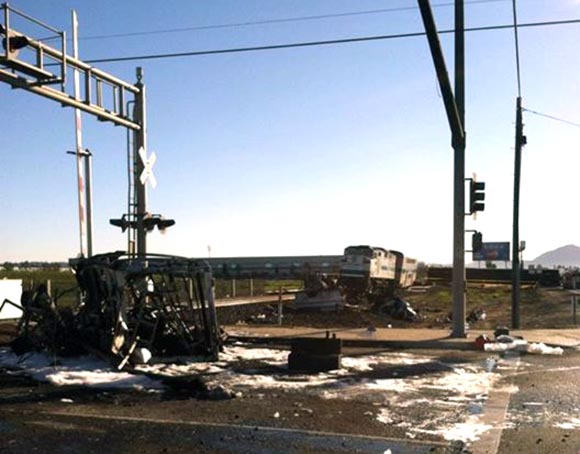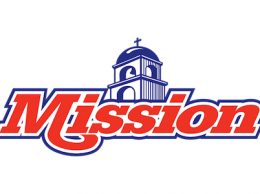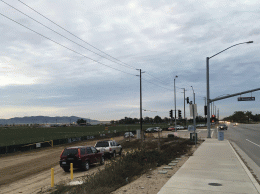
The site of the crash on the morning of Feb. 24. Investigators say a Ford F-450 was driving on the tracks before colliding with the passenger train. (Photo courtesy of Oxnard Fire Department)
The Feb. 24 train crash in Oxnard that injured 28 people has sparked questions about the safety of the railroad crossing that was the site of the accident, while public officials throughout Ventura County continue to scramble for funding for transportation infrastructure improvements.
The crash site at 5th Street and Rice Avenue saw another accident as recently as June of last year, and the Federal Railroad Administration estimates there is a 17.8 percent chance of an accident occurring between a vehicle and train at that particular intersection in any given year. Since 2008, there have been more than five vehicle accidents involving trains there, including one last year that killed two vehicle passengers after the driver failed to stop for a lowered crossing arm at the railroad tracks.
On Feb. 24 a Ford F-450 truck collided with a five-car Metrolink train travelling southbound at 79 miles per hour, causing the train to derail at 5:42 a.m. and injured dozens of passengers, with four in critical condition as of press time. The exact cause of the accident was still under investigation as the Business Times went to press, but officials confirmed at a Feb. 24 press conference that the truck was driving down the railroad tracks just prior to the collision.
“It was not stuck. It was not bottomed out on the track or something like that,” Robert Sumwalt, a board member for the National Transportation Safety Board, told reporters. “We’re very concerned about that; we’re very interested in it.”
The intersection where the accident occurred has been the site of 13 accidents involving trains since 1975, according to the FRA. Construction of a freeway overpass was first proposed over 10 years ago, but the $30 million project has since failed to come to fruition and media reports indicate the project is still in the environmental review phase. Meanwhile, Ventura County officials continue to grapple for funding for the project.
“There’s currently no pot of dedicated funding for that,” said Keith Millhouse, a Moorpark city councilmember who is vice chair of the Ventura County Transportation Commission and second vice chair for Metrolink’s board of directors. “We will work with the city of Oxnard and Union Pacific [Railroad, which owns and operates the tracks,] to make those improvements.”
Ventura County is currently the largest county in the state without a transportation tax. Proposals for such a tax were made in 1994 and 2004, when at least 18 counties in the state with 81 percent of the population had such taxes, according to a Los Angeles Times report at the time. Proposition B, proposed in 2004, would have placed a half-cent levy to bring in about $1.5 billion over the following 30 years. According to Millhouse, a sales tax devoted to transportation would be ideal since local residents wouldn’t be the only taxpayers responsible for the levy.
At a Feb. 23 meeting with Congresswoman Julia Brownley in Port Hueneme, more than two dozen public officials and transportation representatives from across the county took turns addressing Brownley and Peter Defazio, an Oregon Democrat who’s currently the ranking member for the U.S. House Committee on Transportation and Infrastructure, about the transportation funding woes of nearly every city in the county.
“One of the challenges we face in Ventura County is the lack of a clear funding source to increase mass transit…and fix infrastructure such as railroad crossings,” Millhouse said.
In fact, the county took on a $17 million loan from the city of Thousand Oaks to complete a $40 million freeway project in the Conejo Valley. VCTC Executive Director Darren Kettle told public officials at the Feb. 23 meeting the county had no choice but to take the loan so the traffic-easing proposal could move forward.
“We mortgaged four years of our future just to get it done,” he said. “Without the loan, we wouldn’t have gotten this project out the door.”
The site of the Feb. 24 crash in Oxnard is a combination of a road intersection with a regular traffic light and railroad crossing, with signs warning motorists “Do Not Stop on Tracks” along with flashing red warning lights and crossing gates.
“It does need to be safer, and we’ll have to wait and see what the NTSB determines to be the cause,” Millhouse said, adding that VCTC has strove to pinpoint locations in the county in dire need of roadway renovation. “We’ve tried to identify [unsafe] crossings and developed certain guidelines for improvements.”
However, funding remains the biggest challenge for VCTC, as Millhouse said improving that particular intersection is contingent upon getting the money to do it.
“Something else would have to be cut or delayed to get funding for this particular project,” he said. “The money’s just not there.”






 Print
Print Email
Email
















